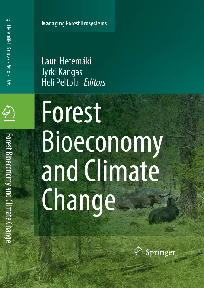A forthcoming book titled Forest Bioeconomy and Climate Change is the first ever science-based book on the subject. Almost 30 European researchers collaborated on its development, considering how the forest bioeconomy can support efforts to overcome the climate crisis in the most sustainable way. Sources: FWPA, Phys Org
Phasing out the use of fossil-based products such as coal, oil and natural gas is central to the fight against climate change, particularly when you consider they are responsible for 75% to 90% of the world’s greenhouse gas emissions.
Contributor Lauri Hetemäki, Professor of Practice at the University of Helsinki and Senior Researcher at the European Forest Institute, argued it is essential we use of forest-based bioproducts as an alternative to fossil fuels, and new innovations in the forest bioeconomy are needed to improve resource efficiency and the recyclability of existing bio-based products.
According to contributor Professor Heli Peltola, Director of the FORBIO project at the University of Eastern Finland, forests must also be managed so they can adapt to the changing climate.
Ensuring the synergies between climate change mitigation efforts and the forestry sector are maximised requires a holistic approach, according to contributor Professor Jyrki Kangas, Deputy Director of the FORBIO project at the University of Eastern Finland.
The book outlines the concept of climate smart forestry as a best practice approach aimed at ensuring the forestry sector is an integral part of the fight against climate change. The approach has three main objectives:
- reducing greenhouse gas emissions
- enabling forests to survive and thrive under changing climate conditions
- maximising the economic benefits of the forestry industry.
Approaches to achieving climate-smart forestry objectives should be tailored based on the conditions of forests in different countries and regions.
In addition, strategies should be designed to be adjusted as the impacts of climate change progress, and disturbances caused by extreme weather events like droughts, storms and forest fires increase.
There is a broad consensus amongst scientists that increasing forest resilience — by planting more mixed forests than monocultural forests and using tree species best suited to habitat — will improve the ability of forests to adapt to suit the conditions of a changing climate, reduce the adverse impacts on the resource, and help prepare the forestry sector for the future.
Tax expenditures alone are unlikely to meet the financial requirements necessary for large-scale forest adaptations, meaning investment from forest owners and the forestry industry is essential.
For that reason, communicating the additional benefits of forestry within and beyond the forestry sector will play an important role in boosting the willingness of forest managers and the broader community to support new forest management measures.
When planning climate-smart approaches, timber production capabilities, economic benefits, employment opportunities and biodiversity objectives should all be considered. Essentially, to be effective, climate smart forest management practices need to take into account socio-economic and ecosystem contexts as well as climate change.
Forest bioeconomy and climate change is based on the FORBIO project (2015–2021), funded by the Strategic Research Council of the Academy of Finland, and coordinated by the University of Eastern Finland in partnership with the European Forest Institute, Finnish Meteorological Institute, Natural Resources Institute Finland, and Finnish Environment Institute.
While the book is not due for publication by Springer until later in 2022, a pre-published manuscript is freely available now via ResearchGate.






